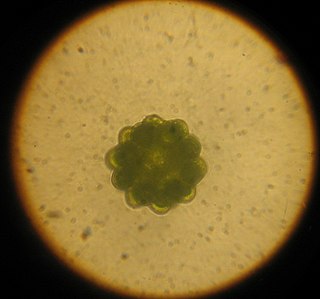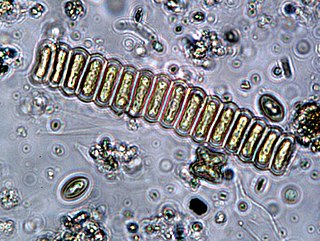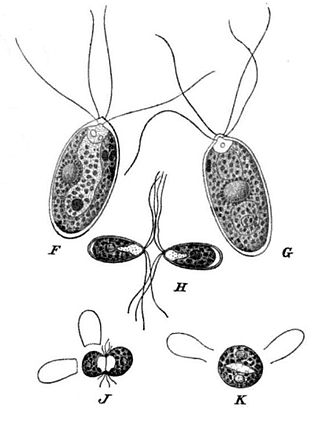
The Chlorophyceae are one of the classes of green algae, distinguished mainly on the basis of ultrastructural morphology. They are usually green due to the dominance of pigments chlorophyll a and chlorophyll b. The chloroplast may be discoid, plate-like, reticulate, cup-shaped, spiral- or ribbon-shaped in different species. Most of the members have one or more storage bodies called pyrenoids located in the chloroplast. Pyrenoids contain protein besides starch. Some green algae may store food in the form of oil droplets. They usually have a cell wall made up of an inner layer of cellulose and outer layer of pectose.

Sphaeropleales is an order of green algae that used to be called Chlorococcales. The order includes some of the most common freshwater planktonic algae such as Scenedesmus and Pediastrum. The Sphaeropleales includes vegetatively non-motile unicellular, colonial, or filamentous taxa. They have biflagellate zoospores with flagella that are directly opposed in direction : Sphaeroplea, Atractomorpha, Neochloris, Hydrodictyon, and Pediastrum. All of these taxa have basal body core connections. Motile cells generally lack cell walls or have only a very fine layer surrounding the cell membrane. Other common characteristics include a robust vegetative cell wall, cup-shaped chloroplasts with large pyrenoids, and relatively large nuclei.

Scenedesmaceae is a family of green algae in the order Sphaeropleales. Scenedesmus algae are commonly found in freshwater plankton. The former family Coelastraceae is considered a synonym of Scenedesmaceae.

Coelastrum is a genus of green algae in the Scenedesmaceae family. It is a common component of the phytoplankton in freshwater habitats such as ponds, lakes, waterfalls, and temporary pools of water, particularly eutrophic ones. The genus has a more or less cosmopolitan distribution, although some species appear to have more restricted geographical distributions.

Eustigmatophytes are a small group of eukaryotic forms of algae that includes marine, freshwater and soil-living species.

Scenedesmus is a genus of green algae, in the class Chlorophyceae. They are colonial and non-motile. They are one of the most common components of phytoplankton in freshwater habitats worldwide.

Chlorococcaceae is a family of green algae, in the order Chlamydomonadales. They are mostly soil-dwelling algae. Many members of this group produce lipids and secondary carotenoids.

Asterococcus is a genus of green algae in the order Chlamydomonadales. It is planktonic in freshwater ponds and lakes, or benthic within mires and swamps. It is a common and widespread genus, but is rarely abundant.

Carteria is a genus of green algae in the family Chlamydomonadaceae. Carteria are similar in morphology to the common genus Chlamydomonas and differ by having four, rather than two, flagella at the vegetative stage.
Dictyochloris is a genus of green algae in the class Chlorophyceae. It is the sole genus of the family Dictyochloridaceae. It is commonly found in terrestrial and subaerial habitats.

Dictyosphaerium is a genus of green algae, in the family Chlorellaceae. It occurs in freshwater habitats around the world and is planktonic. The name comes from the Greek roots diktyon, meaning "net", and sphaira, meaning "ball", referring to its morphology.

Dimorphococcus is a genus of fresh water green algae in the family Scenedesmaceae. It is found as a component of the phytoplankton of freshwater ponds, lakes, and peat bogs. It is widespread, but usually not very common.

Hariotina is a genus of green algae in the family Scenedesmaceae. They are classified in the subfamily Coelastroideae.

Kirchneriella is a genus of green algae in the family Selenastraceae. It is found in freshwater habitats, as phytoplankton or metaphyton.

Monactinus is a genus of green algae in the family Hydrodictyaceae. It is very common in freshwater regions throughout the world.

Planktosphaeria is a genus of Chlorophyceae of the green algae. It was first described by the phycologist Gilbert Morgan Smith in 1918, with Planktosphaeria gelatinosa as its type species. Species of Planktosphaeria are commonly found in freshwater plankton around the world.

Selenastrum is a genus of green algae in the family Selenastraceae. It is common in freshwater habitats around the world. Most species prefer temperate or warm-temperate waters.

Stauridium is a genus of green algae in the family Hydrodictyaceae. It is very common in freshwater regions throughout the world.

Tetraedron is a genus of green algae in the family Hydrodictyaceae. It may also be spelled as Tetraëdron.

Tetrastrum is a genus of green algae (Chlorophyta). It is a common component of the phytoplankton of freshwater habitats, particularly eutrophic and alkaline waters.



















